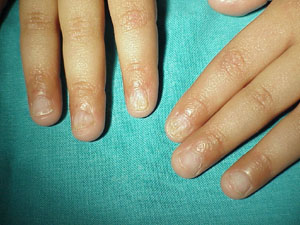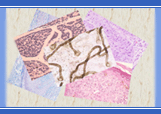|
|
 |
™
 |
| News, April 17, 2005 |
 |
| Thank you for visiting our page. We are working to improve it. New cases coming soon. |
 |
Dyskeratosis Congenita
3/31/2003
Dr. Xavier Allue, Chief of Pediatrics of Hospital de la Seguridad Social, Tarragona, Spain, has contributed this case of Dyskeratosis Congenita.
The picture depicts the hands of a 4 y/o girl diagnosed of DC.

Dyskeratosis Congenita (DC) is a multi-system disorder characterized by
abnormalities of the skin pigmentation, the nails with ridging,
destruction and loss of nails, and the mucous membranes in the form of
white patches on the tongue. 50% of cases might be associated with
abnormalities of the bone marrow, affecting the three series, develping
anemia, infections and bleeding disorders.
A variety of other abnormalities have been reported including
abnormalities of the eyes, teeth, skeletal, gastrointestinal (bowel),
genitourinary (kidneys, bladder) and respiratory systems. There is also an
increased incidence of malignancy particularly of the skin and
gastrointestinal system.
Clinical manifestations of Dyskeratosis Congenita often appear during
childhood. The skin pigmentation and nail changes typically appear first,
usually by the age of 10 years. The more serious complications of bone
marrow failure, thrombocytopenia and aplastic anemia, as well as
malignancies may develop in the second and third decades of life.
Some patients may respond to drugs such as oxymetholone. If the bone
marrow failure is severe and there is a compatible bone marrow donor
treatment by bone marrow transplantation is possible, but the results are
poor.
The majority (90%) of patients are male and show X-linked recessive
patterns of inheritance. The gene responsible for this condition has been identified
and providing an accurate diagnostic test.
The gene (DKCI) was identified in 1998. Autosomal dominant and autosomal
recessive forms also exist. The gene (hTR-RNA component of telomerase)
mutated in autosomal dominant DC was identified in 2001.
|
 |
|








